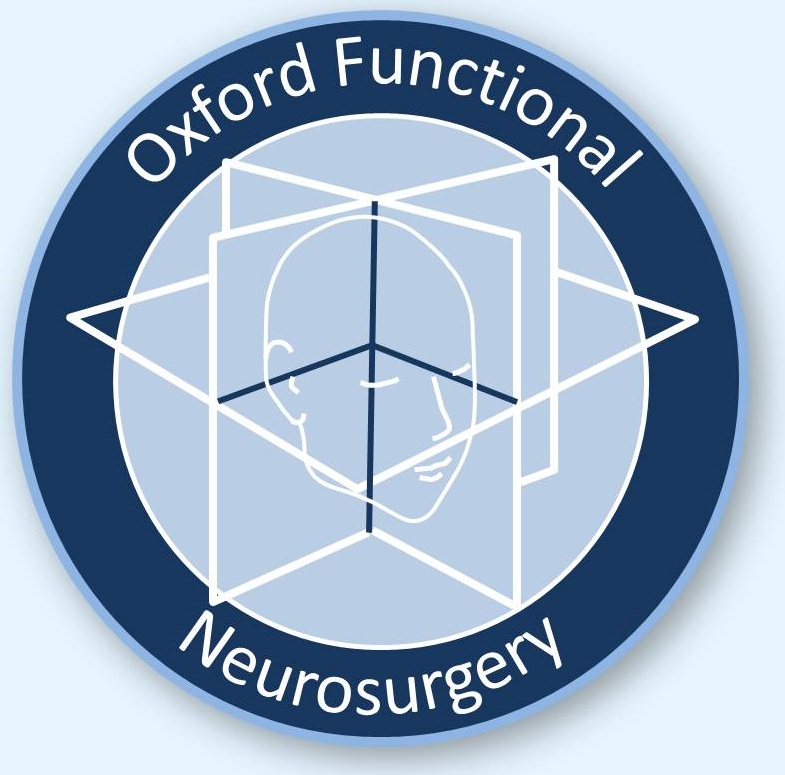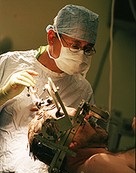Movement disorders
Movement disorders are a group of conditions including Parkinson's disease, dystonia, and tremor. Parkinson's disease is the commonest indication for deep brain stimulation. There are several causes of tremor but the types we most often treat are Essential Tremor (ET), and midbrain tremor as seen in Multiple Sclerosis (MS).
Parkinson's disease
The symptoms of Parkinson's disease (PD) include stiffness, slowness of movement, problems with gait (freezing or shuffling), instability which may lead to falls, and tremor. Patients often report periods of severe symptoms ('off' periods) in between periods of relief when movements are more normal ('on' periods). Initially these symptoms respond well to medication, but after several years of treatment patients often develop more frequent and unpredictable 'off' periods, and unwanted and troublesome movements called dyskinesias may appear during 'on' periods. It becomes progressively harder to find a good level of medication that is enough to prevent the patient being 'off' but without causing dyskinesias.
DBS may be used to treat these 'motor' symptoms. It can alleviate tremor, reduce stiffness, smooth out on/off fluctuations, and lessen dyskinesias. Symptoms vary from patient to patient; for some it is just tremor that bothers them, while for others it may be dyskinesias that are the most troubling. There are four different parts of the brain that can be targeted with DBS for PD, and the choice of target depends on the dominant symptoms. Once we have fully assessed each patient we will advise them as to which option is likely to benefit them most.
In order to be suitable for DBS patients must:
- have a definite diagnosis of PD (as assessed by the UK Parkinson’s Disease Society Brain Bank criteria)
- have motor symptoms severe enough to significantly compromise function and quality of life including on/off fluctuations, dyskinesias or functionally impairing tremor
- be fit to undergo surgery under general anaesthesia (if in doubt we will arrange an anaesthetic assessment)
- have no problems with their blood clotting or platelets
- not have an active infection
- have a life-expectancy of at least 5 years
As a guide, if the reason for treatment is on/off fluctuations and/or dyskinesias, these should be affecting the patient at least 30% of the time, despite a thorough trial of all the appropriate medication. The patient's response to levodopa is also important for us to see as it gives an idea of how good a response there is likely to be to DBS. In order to assess this we will stop the patient's Parkinson's medication for a short time while they are with us for the assessment, then restart it and evaluate the difference it makes.
If the reason for treatment is tremor, to justify surgery it must be severe enough to be significantly interfering with daily living and quality of life, and all appropriate medications must have been tried without success.
It is important to be aware of the limitations of treatment. DBS helps with the same symptoms that levodopa does. In many respects it works better than levodopa - on/off fluctuations are smoothed out, and rather than producing dyskinesias it can actually relieve them. But, like levodopa there are some symptoms that DBS will not improve, including for example problems with speech and any cognitive difficulties. And like levodopa, DBS will not stop the PD from progressing over time.
Dystonia
Dystonia is a movement disorder characterised by sustained involuntary muscle contractions leading to twisting movements and abnormal posturing. It may affect part of the body ('focal' dystonia, e.g. spasmodic torticollis) or it may affect much or all of the body ('generalised' dystonia). It can be a painful and disfiguring disease that leaves the patient both physically and socially disabled, and most types do not respond well to any medications.
In a minority of patients with dystonia there is an identifiable cause such as traumatic brain injury, cerebral palsy, or drug exposure, or a genetic cause. However in most cases we do not know why it happens.
DBS may help treat all forms of dystonia. Complete remission is rare, but in most cases symptoms are made substantially milder.
In order to be suitable for DBS patients must:
- have an established clinical diagnosis of dystonia, as determined by a consultant neurologist in the functional neurosurgery team, and which is of sufficient severity to compromise quality of life
- have tried all appropriate medications without success
- not have significant fixed joint deformities
- be fit to undergo surgery under general anaesthesia (if in doubt we will arrange an anaesthetic assessment)
- have no problems with their blood clotting or platelets
- not have an active infection
Patients with cervical dystonia should have tried botulinum toxin therapy before consideration of DBS.
In rare cases dystonia can be dramatically improved by treatment with a medication called levodopa, and patients should in general have a trial of this medication prior to proceeding to DBS.
Essential Tremor (ET)
The major problem in this condition is usually shaking of the hands, although other areas including the head can be involved. When severe the tremor may interfere with eating and drinking as well as other daily activities. As important as the disability is the resulting social embarrassment. Often the patient will have had ET for many years before seeking help and commonly they will have noticed that it improves with even a small amount of alcohol. It may run in families.
DBS can dramatically reduce the tremor in ET. However it is always important to ensure that simpler treatment options have been tried without success first.
In order to be suitable for DBS patients must:
- have an established diagnosis of essential tremor or dystonic tremor as determined by a consultant neurologist in the functional neurosurgery team
- have tremor sufficient to significantly impair quality of life
- have tried all appropriate medical treatments without success. For essential tremor this usually includes four month trials of beta blockers, primidone, gabapentin, and topirimate. For dystonic tremor it usually includes a four month trial of anticholinergic medication.
- be likely to obtain a functionally useful improvement in disability if their tremor is treated successfully
- be fit to undergo surgery under general anaesthesia (if in doubt we will arrange an anaesthetic assessment)
- have no problems with their blood clotting or platelets
- not have an active infection
Midbrain tremor
We most commonly see this form of tremor in patients with multiple sclerosis (MS). Whereas ET is mainly seen as a shaking in the hands, midbrain tremor tends to be a more violent movement, often involving the shoulder so that the whole arm may flail around.
DBS may be effective in controlling the tremor, but the results are less certain than with other movement disorders. Part of the reason for this is that the tremor is often accompanied by a degree of "clumsiness" (known as ataxia) which the DBS cannot help with. When we see MS patients for the first time, one thing we will pay special attention to before planning DBS is working out whether the main problem is tremor or ataxia.
In order to be suitable for DBS patients must:
- have an established diagnosis of midbrain tremor, with an identified cause, as determined by a consultant neurologist in the functional neurosurgery team
- have tremor that is severe enough to significantly compromise quality of life and performance of activities of daily living
- have had a four month trial of gabapentin without success
- not have spasticity, weakness, or numbness that would prevent a return of function if tremor is removed. If the cause is MS then the predominant functional impairment must be due to tremor rather than ataxia
- have had an MRI scan which does not demonstrate pathological involvement or destruction of the target site for DBS
- be fit to undergo surgery under general anaesthesia (if in doubt we will arrange an anaesthetic assessment)
- have no problems with their blood clotting or platelets
- not have an active infection
Even for experienced neurologists it is not always easy to predict which MS patients will respond well to DBS.
Copyright OFN Wednesday, 11 February, 2015.













